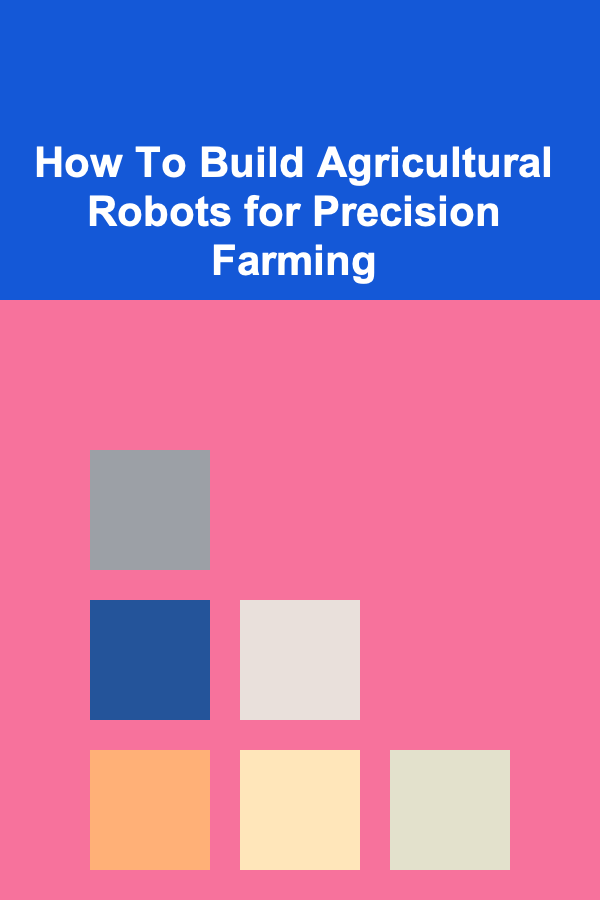
How To Build Agricultural Robots for Precision Farming
ebook include PDF & Audio bundle (Micro Guide)
$12.99$6.99
Limited Time Offer! Order within the next:

Agriculture has come a long way from traditional farming methods, thanks to the advent of modern technology. One of the most promising innovations in recent years is agricultural robotics, which is revolutionizing the way we approach farming. Precision farming, in particular, relies heavily on the use of advanced technologies like agricultural robots to optimize crop production, reduce waste, and enhance sustainability.
Building agricultural robots for precision farming involves a deep understanding of various technologies, such as robotics, artificial intelligence (AI), machine learning, sensors, and automation. This article will walk through the process of building agricultural robots for precision farming, from understanding the requirements to the design, development, and implementation of these machines.
Understanding the Role of Agricultural Robots
Agricultural robots are machines designed to automate tasks that traditionally require human labor. They are used to perform a variety of functions, including planting, harvesting, watering, spraying, and monitoring crops. Precision farming, which aims to maximize yield while minimizing the environmental impact, benefits significantly from the use of these robots.
Benefits of Agricultural Robots in Precision Farming
- Increased Efficiency: Robots can work continuously without fatigue, leading to significant increases in efficiency compared to human labor. This allows farmers to cover more ground and complete tasks faster.
- Precision and Accuracy: Agricultural robots are equipped with sensors and cameras that allow them to monitor crops at a granular level. This enables precise applications of water, fertilizers, pesticides, and herbicides, reducing waste and minimizing the environmental impact.
- Cost Reduction: By automating labor-intensive tasks, robots reduce the need for manual labor, leading to cost savings. They also reduce the usage of resources like water and chemicals, leading to more sustainable farming practices.
- Data Collection and Analysis: Many agricultural robots are equipped with advanced data collection systems. They can gather information on soil conditions, crop health, and weather patterns, which can be used for data-driven decision-making and better farm management.
Components of an Agricultural Robot
Building an agricultural robot for precision farming involves several key components that work together to enable automation and precision. These include hardware, sensors, control systems, and software.
2.1 Hardware Components
- Chassis and Structure: The chassis provides the physical framework of the robot. It needs to be sturdy yet lightweight to allow easy movement through fields, which may be uneven or challenging. The material used must also withstand harsh outdoor conditions.
- Motors and Actuators: Motors are essential for movement, while actuators are used to perform specific tasks, such as opening and closing valves for irrigation or applying fertilizers. These components allow the robot to perform tasks like navigating fields or handling equipment.
- Power Supply: Agricultural robots require a reliable power source. Most robots today use electric motors, and their power comes from rechargeable batteries. Solar panels can also be integrated for sustainable power, especially in regions with abundant sunlight.
- Wheels or Tracks: Depending on the terrain, robots may use wheels or tracks to move across the farm. Tracks are often preferred for rough or muddy terrain as they distribute weight more evenly, preventing the robot from getting stuck.
2.2 Sensors and Cameras
Sensors are the eyes and ears of agricultural robots. They allow the robot to understand its environment and make data-driven decisions. Some key sensors used in agricultural robots include:
- LiDAR (Light Detection and Ranging): LiDAR sensors use laser light to measure distances to objects. They help the robot create a 3D map of the environment, which is essential for navigation and obstacle avoidance.
- Cameras: High-resolution cameras, including RGB and multispectral cameras, capture detailed images of crops. These images can be analyzed to assess the health of crops, detect diseases, or identify pests.
- GPS: Global Positioning System (GPS) is crucial for precise navigation. Agricultural robots rely on GPS to track their location on the farm and ensure they stay on course during tasks like spraying or harvesting.
- Soil Moisture Sensors: These sensors measure the moisture content of the soil, which is vital for irrigation. They allow the robot to apply water only where it's needed, reducing waste and conserving resources.
- Temperature and Humidity Sensors: These sensors monitor the environmental conditions, providing data on the temperature and humidity of the soil and air. This information helps the robot make decisions about irrigation, spraying, or other climate-sensitive tasks.
2.3 Control Systems
Control systems are the brains behind agricultural robots. They process the data from sensors and cameras, analyze it, and send commands to the robot's motors and actuators. These systems typically consist of:
- Microcontrollers: Microcontrollers act as the central unit for controlling the robot's operations. They receive input from sensors and execute commands based on pre-programmed algorithms or real-time data analysis.
- Navigation Systems: Navigation is one of the most crucial aspects of an agricultural robot. It involves both hardware (such as GPS and LiDAR sensors) and software that helps the robot navigate the farm. Autonomous navigation ensures that robots can work without human intervention.
- Communication Systems: Agricultural robots often communicate with a central system or cloud platform to send data, receive updates, or monitor their status. Communication systems, such as wireless networks or Bluetooth, facilitate remote control and real-time data transfer.
2.4 Software and AI
Software is where the magic happens. The algorithms that control how the robot performs tasks, makes decisions, and interacts with its environment are all programmed into the robot's software. Key software components include:
- Machine Learning Algorithms: Machine learning (ML) enables agricultural robots to learn from data and improve their performance over time. For instance, ML can help robots recognize different types of crops, identify diseases, or optimize irrigation based on environmental factors.
- Computer Vision: Computer vision algorithms process images from cameras to identify and track crops. This allows robots to make decisions about which plants need water, fertilizer, or pesticide.
- Data Analysis and Cloud Computing: Most modern agricultural robots are connected to the cloud, where large volumes of data are processed and analyzed. This data can be used for predictive analytics, helping farmers anticipate crop yields, monitor plant health, or forecast weather patterns.
Designing an Agricultural Robot
3.1 Define the Problem and Requirements
The first step in building an agricultural robot is to define the problem you're trying to solve. Precision farming can encompass a wide range of tasks, so it's crucial to narrow down the specific requirements of the robot. Common tasks that agricultural robots perform include:
- Crop monitoring
- Automated harvesting
- Weed detection and removal
- Irrigation management
- Fertilizer and pesticide application
Each task will have its own set of requirements, such as the type of sensors needed, the level of autonomy, the power source, and the robot's mobility.
3.2 Design the System Architecture
Once you've defined the problem, the next step is to design the system architecture. This involves selecting the hardware and software components that will be used to build the robot. The system architecture should outline:
- The types of sensors and cameras required
- The control system and communication methods
- Power requirements and battery life
- The type of robot (e.g., autonomous vehicle, drone, or stationary unit)
3.3 Prototyping and Testing
After designing the system architecture, it's time to create a prototype. This stage involves building a working model of the robot that incorporates the selected components. Prototyping allows you to test and validate the robot's functionality before full-scale production.
During the testing phase, the robot is put through real-world conditions to see how well it performs. It's essential to conduct tests under various scenarios, such as different types of terrain, weather conditions, and crop varieties, to ensure that the robot can handle all challenges it may face in the field.
Implementing the Robot in the Field
4.1 Field Trials and Calibration
Before deploying the robot on a large scale, it's essential to run field trials to ensure it performs as expected. During these trials, you'll need to calibrate sensors, adjust algorithms, and fine-tune the robot's behavior to improve performance.
4.2 Integration with Farm Management Systems
Agricultural robots can be integrated with farm management systems (FMS) to collect and analyze data. These systems help farmers monitor their crops in real-time, make decisions based on the data collected, and optimize farming practices. For instance, the data from the robot's sensors can be used to adjust irrigation schedules, predict harvest times, or identify areas of the farm that need attention.
4.3 Continuous Monitoring and Updates
After deployment, it's important to continuously monitor the performance of the agricultural robot. Over time, software updates, hardware repairs, or additional features may be necessary to ensure the robot remains effective. Regular maintenance is key to ensuring the robot operates at peak efficiency.
Challenges and Future Directions
While agricultural robots have shown great promise, there are several challenges that need to be addressed for them to become more widespread:
- Cost: The initial cost of agricultural robots can be high, especially for small-scale farmers. Reducing production costs and making robots more affordable is crucial for their widespread adoption.
- Environmental Variability: Agricultural robots need to operate in diverse environments with varying soil types, weather conditions, and crops. Developing robots that can adapt to these changes is a key challenge.
- Data Privacy and Security: With the increasing use of sensors and data collection, ensuring data privacy and security becomes crucial. Farmers must have control over the data collected by their robots and ensure it is protected from cyber threats.
The future of agricultural robots is bright, with advancements in AI, machine learning, and robotics paving the way for more intelligent and efficient machines. As technology continues to evolve, we can expect agricultural robots to become more affordable, versatile, and capable of handling an even wider range of tasks, making precision farming more accessible to farmers worldwide.
By building agricultural robots for precision farming, we are not only enhancing productivity but also promoting sustainable and environmentally friendly farming practices. The future of agriculture lies in automation, and with the right tools, we can build robots that help farmers grow healthier, more abundant crops while conserving valuable resources.

How to Choose the Perfect Color Scheme for Your Home Renovation
Read More
How to Choose the Right E-Commerce Platform for Your Online Sales
Read More
How to Plan for Retirement at Any Age
Read More
How to Use Index Funds to Grow Your Wealth Over Time
Read More
How to Build a Strong Team Chemistry
Read More
Mastering Mixed-Media Sketchbooking: A Deep Dive into Creative Exploration
Read MoreOther Products

How to Choose the Perfect Color Scheme for Your Home Renovation
Read More
How to Choose the Right E-Commerce Platform for Your Online Sales
Read More
How to Plan for Retirement at Any Age
Read More
How to Use Index Funds to Grow Your Wealth Over Time
Read More
How to Build a Strong Team Chemistry
Read More